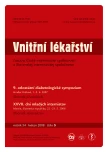Diabetes, dyslipidaemia and kidney diseases
Authors:
R. Češka 1; V. Tesař 2
Authors‘ workplace:
III. interní klinika 1. lékařské fakulty UK a VFN Praha, přednosta prof. MUDr. Štěpán Svačina, DrSc., MBA
1; Nefrologická klinika 1. lékařské fakulty UK a VFN Praha, přednosta prof. MUDr. Vladimír Tesař, DrSc.
2
Published in:
Vnitř Lék 2008; 54(5): 511-517
Category:
Předneseno na 9. celostátním diabetologickém sympoziu „Diabetes a urogenitální systém“ ve dnech 1.-2. června 2007 v Novém Adalbertinu v Hradci Králové.
Overview
Dyslipidemia (DLP) is the most significant risk factor for cardiovascular diseases (CVD). Similarly, the relevance of diabetes mellitus (DM) as a CVD risk indicator is so high that it is attributed the same significance as the secondary prevention of CVD in different systems of global cardiovascular risk assessment. Most recently, also kidney disorders have been increasingly referred to as a risk factor for the manifestation of CVD. According to some guidelines, patients with kidney disorders are at the same risk as the patients with manifest IHD (or another manifestation of atherosclerosis), and patients with DM. This paper does not pretend to resolve the complex relationship between DLP, DM and nephropathy. Its sole objective is to bring attention to the fact that it is a relevant and significant issue which is gradually becoming a central point of attention. The first part of the article deals primarily with diabetic DLP and the different options for its management. The second part deals with the role of DLP in kidney disorders, the risk it represents and the options for its management, as well as with the results of the first intervention studies. The studies focused on the effect of hypolipidemic therapy on CV risk of patients on the one hand and, on the other hand, on the way hypolipidemic drugs contribute to the improvement or sustaining of renal functions, or on their influence on renal disease markers.
Key words:
dyslipidaemia – renal insufficiency – nephropathy – albuminuria – statins – fibrates – ezetimibe – hypolipidemic drugs
Sources
1. Yusuf S et al. INTERHEART. Lancet 2004; 364: 937–952.
2. A Joint Editorial Statement by the ADA, NHLBI, AHA et al. Diabetes mellitus: A major risk factor for cardiovascular disease. Circulation 1999; 100: 1132–1133.
3. Haffner SM. Coronary heart disease in patients with diabetes. N Engl J Med 2000; 342: 1040–1042.
4. Executive summary of the third report of the NCEP expert panel on detection, evaluation and treatment of high blood cholesterol in adults (Adult treatment panel III). JAMA 2001; 285: 2486–2497.
5. Češka R et al. Cholesterol a ateroskleróza, léčba dyslipidémií. Praha: Triton 2005.
6. The FIELD Study Investigators. Lancet [Early Online Publication]. November 14, 2005.
7. Keech AC, Mitchell P, Summanen PA et al. Effect of fenofibrate on the need for laser treatment for diabetic retinopathy (FIELD study): a randomised controlled trial. Lancet 2007; 370: 1687–1697.
8. Holdaas H et al. The ALERT study. Lancet 2003; 361: 2024–2031.
9. Wanner Z et al. Die Deutsche Diabetes Dialyse Studie (4D). Kidney Int 2003, 14: 1605–1613.
10. O’Keefe JH et al. Improving the adverse cardiovascular prognosis of type 2 diabetes. Mayo Clin Proc 1999; 74: 171–180.
11. Austin MA, Edwards KL. Small, dense low density lipoproteins, the insulin resistance syndrome and noninsulin–dependent diabetes. Curr Opin Lipidol 1996; 7: 167–171.
12. Austin MA et al. Low-density lipoprotein subclass patterns and risk of myocardial infarction. JAMA 1988; 260: 1917–1921.
13. Sniderman AD et al. Hypertriglyceridemic hyperapoB in type 2 diabetes. Diabetes Care 2002; 25: 579–582.
14. Lamarche et al. Small, dense lowdensity lipoprotein particles as a predictor of the risk of ischemic heart disease in men. Prospective results from the Québec Cardiovascular Study. Circulation 1997; 95: 69–75.
15. Colhoun HM, Betteridge DJ, Durrington PN, et al. Primary prevention of cardiovascular disease with atorvastatin in type 2 diabetes in the Collaborative Atorvastatin Diabetes Study (CARDS): multicentre randomised placebo-controlled trial. Lancet 2004; 364: 685–696.
16. Keech A. Effects of long-term fenofibrate therapy on cardiovascular events in 9795 people with type 2 diabetes mellitus (the FIELD study): randomised controlled trial. Lancet 2005; 366: 1849–1861.
17. Mann et al. Renal insufficiency as a predictor of cardiovascular outcomes and the impact of ramipril: the HOPE randomized trial. Ann Intern Med 2001, 134: 629–636.
18. Holdaas et al. Effect of fluvastatin on cardiac outcomes in renal transplant recipients: a multicentre, randomised, placebo- controlled trial. Lancet 2003; 361: 2024–2031.
Labels
Diabetology Endocrinology Internal medicineArticle was published in
Internal Medicine

2008 Issue 5
Most read in this issue
- Metformin and kidneys
- Haemocoagulation and renal insufficiency, haemocoagulation and type 2 diabetes mellitus
- Specific issues of dialysed diabetics in outpatient practice
- Examination of the kidneys in a diabetic patient
